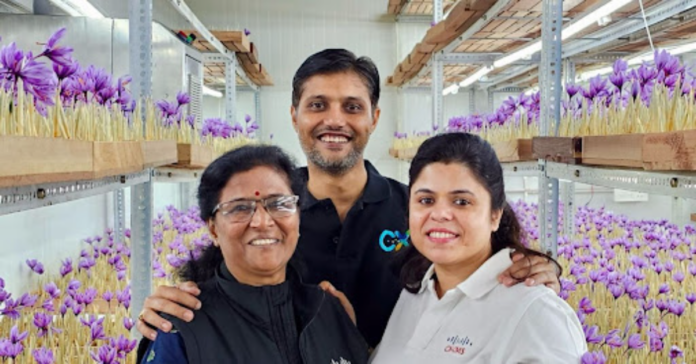Growing Saffron Indoors has emerged as a revolutionary farming method, and Sujata Agarwal from Jharsuguda, Odisha, has taken this innovation to new heights. Starting in a 100-square-foot room, Sujata’s journey into saffron cultivation has not only challenged traditional farming practices but also turned into a lucrative business, with saffron selling at an impressive ₹10 lakh per kilogram. Her success story is an inspiring tale of perseverance, creativity, and resourceful use of modern technology.
The Beginnings of an Unlikely Venture
Sujata Agarwal’s interest in growing saffron indoors was sparked in 2022 when she came across videos on YouTube about indoor farming. Saffron, traditionally grown in colder climates like Kashmir, was a crop she thought impossible to cultivate in the humid conditions of Odisha. However, determined to challenge the norm, she began researching indoor cultivation techniques, focusing on hydroponics and controlled environment agriculture.
Unlike traditional saffron farming, which requires expansive fields and specific climatic conditions, Sujata’s indoor setup was compact and efficient. Using a 100-square-foot room equipped with grow lights, temperature control systems, and nutrient-rich soil substitutes, she successfully created the optimal environment for saffron cultivation.
Twice-A-Year Harvests in a Small Space
One of Sujata’s most remarkable achievements is her ability to harvest saffron not once but twice a year. Traditional saffron farming typically yields only one harvest annually, but the controlled indoor environment allows her to speed up the growing cycle. By regulating light, temperature, and humidity, she has mastered the art of producing high-quality saffron in significantly less time.
This innovation has given her a competitive edge in the market, as she can supply fresh saffron twice as often as conventional farmers. Moreover, the compact setup allows her to produce the same quantity of saffron that would typically require several acres of farmland.
Why Saffron Is So Valuable?
Saffron, often referred to as “red gold,” is one of the most expensive spices in the world. Its high price is due to the labor-intensive process of harvesting the delicate stigmas of the saffron crocus flower. Each flower produces only three stigmas, and it takes around 150,000 flowers to produce just one kilogram of saffron.
The spice’s value is further enhanced by its numerous uses in cooking, medicine, and cosmetics. Sujata not only sells raw saffron but also adds value to her produce by creating saffron-based serums and traditional beverages like kahwa, expanding her product line and boosting her revenue.
The Science Behind Indoor Saffron Farming
Sujata’s success with growing saffron indoors lies in her use of modern agricultural technology. She employs hydroponics, a soil-less farming method where plants are grown in a nutrient-rich water solution. This technique minimizes water wastage and ensures that the plants receive the exact nutrients they need for optimal growth.
Additionally, her setup includes LED grow lights that mimic natural sunlight, promoting photosynthesis even in an enclosed space. A temperature control system maintains the cool conditions required for saffron cultivation, while automated humidity regulators prevent fungal growth, which is a common issue in traditional farming.
Challenges and Overcoming Them
Despite her success, Sujata faced several challenges when starting her venture. Saffron is a notoriously delicate crop, and achieving the right balance of temperature, light, and nutrients required extensive trial and error. Moreover, the initial cost of setting up an indoor farming system was high, with expenses for equipment, seeds, and training.
However, Sujata tackled these challenges with determination. She sought advice from agricultural experts, attended workshops on indoor farming, and applied for government subsidies to reduce her financial burden. Her efforts paid off, and she now serves as a role model for other aspiring farmers.
Economic Impact and Future Plans
Sujata’s venture into growing saffron indoors has not only transformed her life but also created economic opportunities in her community. She employs local workers to assist with planting, harvesting, and packaging, providing them with valuable skills and a steady income. Her success has also inspired other farmers in Odisha to explore indoor farming, potentially revolutionizing agriculture in the region.
Looking ahead, Sujata plans to expand her operations by setting up additional indoor farms and exploring new markets for her products. She is also keen to share her knowledge with others, conducting training sessions for farmers interested in adopting similar techniques.
The Environmental Benefits of Indoor Farming
Indoor farming, as demonstrated by Sujata’s success, offers several environmental benefits. By growing crops in a controlled environment, water usage is significantly reduced compared to traditional farming methods. Additionally, the absence of soil minimizes the need for harmful pesticides, making indoor farming a more sustainable option.
Sujata’s use of renewable energy sources, such as solar panels to power her equipment, further reduces the environmental impact of her farming operations. This eco-friendly approach aligns with global efforts to combat climate change and promote sustainable agriculture.
A Visionary Approach to Farming
Sujata Agarwal’s journey into growing saffron indoors is a testament to the power of innovation and determination. By challenging traditional methods and embracing modern technology, she has turned a small indoor setup into a highly profitable business. Her story is an inspiration for anyone looking to venture into agriculture, proving that even the most ambitious goals can be achieved with the right mindset and resources.
As the demand for high-quality saffron continues to grow, Sujata’s success underscores the potential of indoor farming to meet this demand while overcoming the limitations of traditional agriculture. Her achievements serve as a shining example of how innovation can transform challenges into opportunities, paving the way for a brighter future in farming.


/startuppedia/media/media_files/2BiaBQGleHKbkFkPH924.jpeg)

